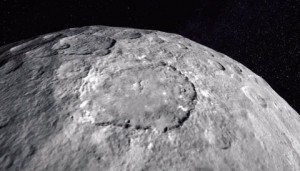Visit the dwarf planet Ceres in this video animation created from images taken by NASA’s Dawn spacecraft.

Feeling stir-crazy? Take a trip to Ceres, the largest asteroid in the main belt. Your rocket ship might not be fueled and ready for takeoff, but thanks to NASA’s Dawn mission you can see Ceres virtually.
Dawn arrived at Ceres in March, and since then it’s been slowly spiraling closer to the dwarf planet, checking out features such as the weird bright spots. This JPL video (below) is based on 80 images taken by Dawn during its first mapping orbit, 13,500 km (8,400 miles) above the surface. Team members analyzed overlapping images to create the 3D terrain. Even so, the video is not true to life: the team doubled the vertical dimension, exaggerating features’ prominence. So what you see in the video is a souped-up version of what Dawn is seeing as it orbits the asteroid.
Since taking these images, the spacecraft has descended into a lower, survey orbit only 4,400 km above the surface. It’ll stay in this orbit for three weeks, using both camera and spectrometer to create global maps as it circles the asteroid about once every three Earth days. After that, it’ll continue descending into two even lower orbits, ultimately reaching an altitude of only 375 km. That’s about the same altitude as the International Space Station’s orbit above Earth.
 2
2









Comments
Peter Wilson
June 9, 2015 at 11:57 am
The vertical relief has been exaggerated by a factor of two.
And that was necessary because…?
You must be logged in to post a comment.
Anthony Barreiro
June 10, 2015 at 6:38 pm
Exaggerating the vertical scale makes relief features like crater walls easier to see, especially under less than ideal angles of illumination, i.e. when the Sun is high overhead and not casting long shadows.
It would be interesting to see an unexaggerated version for comparison, but I am nonetheless grateful for this fascinating video. The Dawn, Rosetta, and New Horizons spacecraft are helping us get to know our little neighbors so much more intimately! It's good there aren't any life forms on Ceres, Comet Churyumov-Gerasimenko, or Pluto -- they might not want our drones flying overhead taking pictures of their back yards!
You must be logged in to post a comment.
You must be logged in to post a comment.